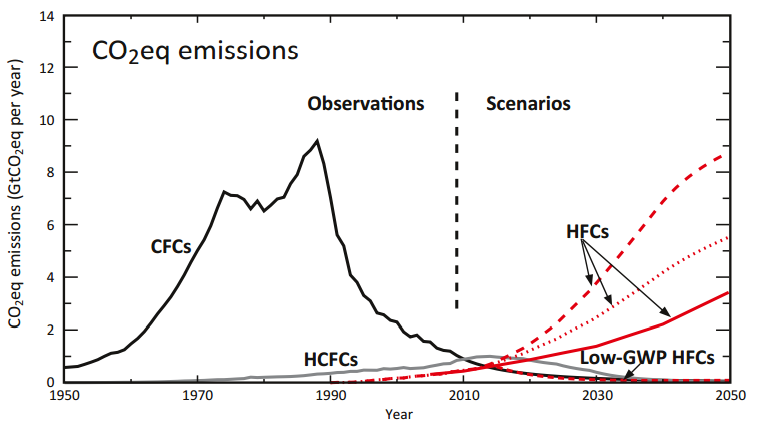
Refrigerators and spray cans: HFC policies are a perfect complement to carbon pricing

Part three of our blog series on complementary climate policies explores the recent global agreement to curb the use of hydrofluorocarbons—a potent greenhouse gas used in refrigerators, air conditioners, and spray cans. Specifically, we look at how a targeted policy that reduces HFCs under the global agreement is a complement to carbon pricing here in Canada.
It all started with a different environmental problem…
Scientists in the 1970s discovered that a set of gases commonly used as refrigerants and aerosols—called chlorofluorocarbons (CFCs)—were burning a hole in the ozone layer, increasing exposure to harmful ultraviolet radiation. This led to the signing of the Montreal protocol in 1987, calling for a phase-out of CFCs.
The agreement was very effective. Consumption of CFCs dropped from over 1000 kilotonnes per year in the 1980s to nearly zero in 2010, and the ozone layer has been recovering since. And because CFCs are also a potent greenhouse gas, the Protocol had the added benefit of significantly reducing global emissions (see figure 1). Almost by accident, it is regarded as one of the biggest steps to address climate change to date. Canada complied with the Protocol by prohibiting the production and import of CFCs, coupled with a longer phase-out for less potent ozone-depleting substances.
Hydrofluorocarbons (HFCs) were one of the main substitutes for CFCs. These have benign effects to the ozone layer, but, just like the CFCs they replaced, HFCs are potent greenhouse gases (up to 14,800 times more potent than carbon dioxide). The result was swapping one GHG for another (although the rate of substitution was less than one-for-one).

Emissions from HFCs are still well below the peak emissions from CFCs and represent only 2% of global emissions. However, they are the fastest growing source of GHG emissions, driven by increasing demand for air conditioners and refrigerators. In Canada, HFC emissions represent less than 1% of total emissions, but increased by 450% between 1995 and 2013. Unabated, forecasts suggest that HFC emissions could completely undo the progress from the Montreal Protocol (see figure 2).
To prevent this from happening, the global community agreed to add an amendment to the Montreal Protocol last October. It creates legally binding targets for the 197 signatory countries to make deep cuts to the use of HFCs. This could reduce emissions by an additional 4 billion tonnes a year, or roughly one-tenth of the emissions reductions necessary to keep the world within a ‘safe’ range of temperature rise.
HFC regulations are a complement to carbon pricing, not a substitute
So far, carbon pricing regimes in Canada and abroad have excluded HFCs emissions. HFCs are a type of ‘process emission.’ Unlike other major sources of GHGs, such as emissions from combusting fossil fuels, HFC emissions are emitted from a larger, more diffused number of sources, making them difficult to measure. The volume and rate of HFC emissions can also depend on how the product containing the gases are disposed of. These characteristics therefore make it extremely challenging to include within the coverage of a carbon price.
As a result, targeted policies which reduce HFC emissions can fill a critical gap not covered by carbon pricing. Broader policy coverage is more effective: it reduces additional emissions from additional sources. But it is also more cost-effective, particularly when considering the low-cost opportunities currently available to shift away from HFCs.
By the same token, HFC policies are no substitute for an economy-wide carbon price. HFC emissions represent a relatively small fraction of total GHGs in the atmosphere; the regulations that enforce the Protocol will not address these other, more abundant gases (such as carbon dioxide, methane, or nitrous oxide). So, although HFC regulations are an important piece to GHG mitigation, they are clearly not a stand-alone substitute to carbon pricing.
Not all HFC policies are created equal
Environment and Climate Change Canada (ECCC) is in the early stages of developing regulations to achieve Canada’s commitments under the Montreal Protocol. Several options are possible, but each are likely to have varying degrees of effectiveness and costs.
Governments can outright ban the use of HFCs, or only ban specific HFCs that exceed a given potency threshold (different types of HFCs have different global warming potential). These tend to be more costly options, as it gives emitters less flexibility in how they choose to comply with the regulation, but can nevertheless be very effective, as illustrated by the speedy phase-out of CFCs.
Other, more flexible options include creating a cap on the total amount of HFC emissions allowed, and establishing a market to facilitate trading among emitters. Or, as is already underway in Norway, governments could even create a specific tax on HFCs, refunded when products are properly disposed of.
When to take a complement
Hydroflurocarbons are a small subset of global GHG emissions, yet have serious potential to accelerate climate change. Considering the limitations of including HFCs within carbon pricing policies, targeted regulations for these gases make absolute sense. Canada’s actions will also be part of a collective global effort to reduce HFCs, building on the previous successes of the Montreal Protocol.
But we must not forget that the details of Canada’s approach, while still in the hopper, will have important implications for how effectively and cost-effectively the policy reduces HFC emissions. Just like with other climate policies, options that strike a balance between flexibility, stringency, and predictability tend to reduce emissions at the smallest economic cost. If the right balance can be struck, smart HFC regulations can help improve the overall performance of Canada’s climate policy.




Comments are closed.